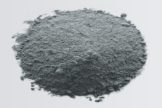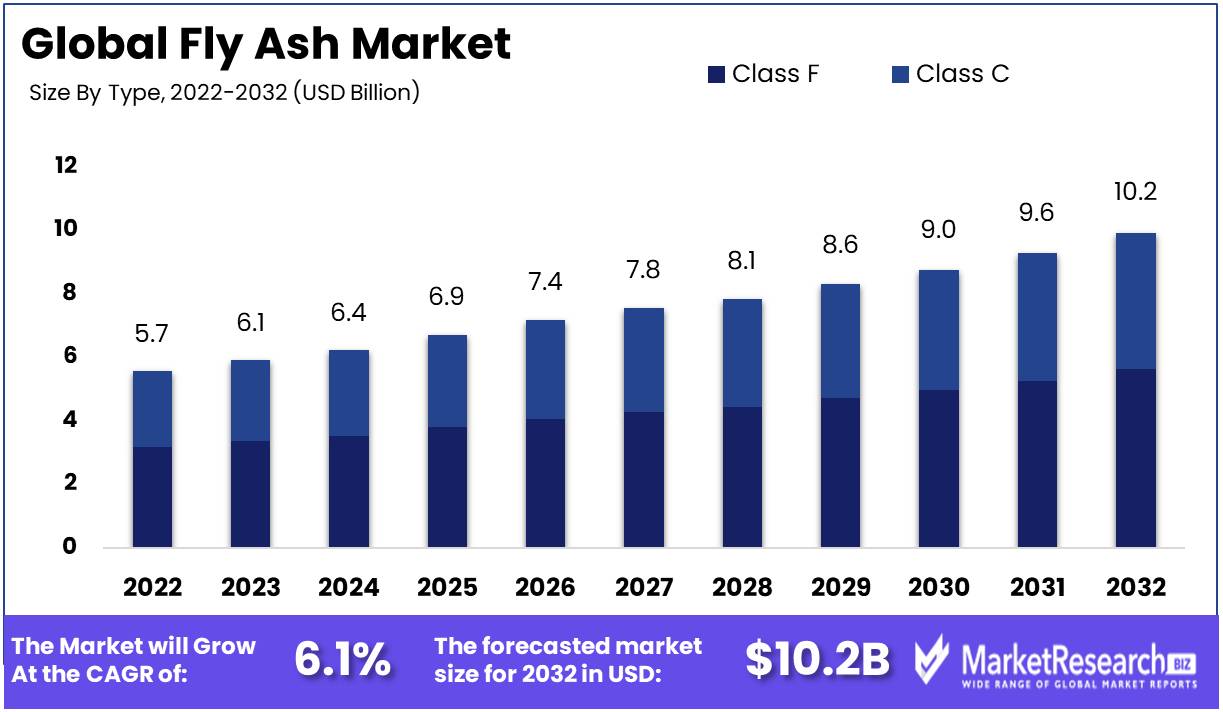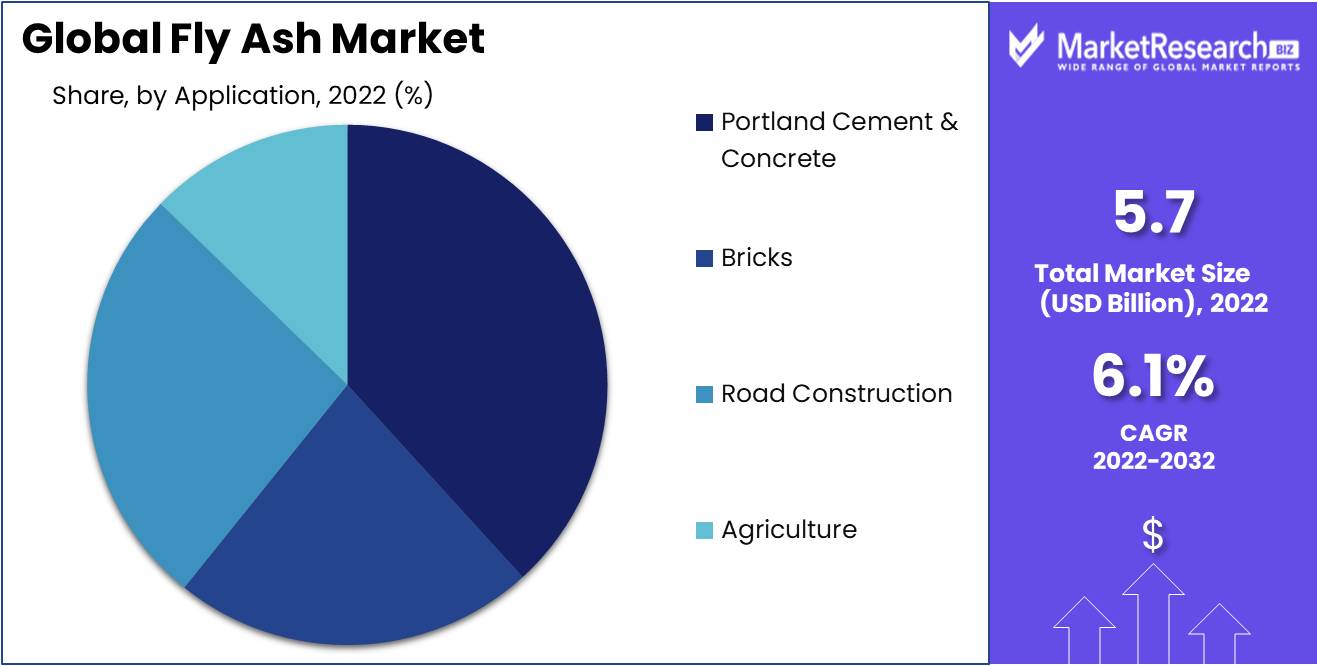
Fly Ash Market By Type(Class F, Class C) By Application(Portland Cement & Concrete, Bricks, Road Construction, Agriculture, and Others), By Region And Companies - Industry Segment Outlook, Market Assessment, Competition Scenario, Trends, And Forecast 2023-2032
-
6499
-
May 2023
-
185
-
-
This report was compiled by Kalyani Khudsange Kalyani Khudsange is a Research Analyst at Prudour Pvt. Ltd. with 2.5 years of experience in market research and a strong technical background in Chemical Engineering and manufacturing. Correspondence Sr. Research Analyst Linkedin | Detailed Market research Methodology Our methodology involves a mix of primary research, including interviews with leading mental health experts, and secondary research from reputable medical journals and databases. View Detailed Methodology Page
-
Quick Navigation
Report Overview
Fly Ash Market size is expected to be worth around USD 10.2 Bn by 2032 from USD 5.7 Bn in 2022, growing at a CAGR of 6.1% during the forecast period from 2023 to 2032.
The Fly Ash Market report presents a comprehensive and in-depth analysis of the industry, unraveling key trends, growth drivers, and obstacles in a tangled web. In addition, it provides a comprehensive overview of market segmentation, regional analysis, and the competitive landscape, as well as an abundance of insights into emerging opportunities and potential threats. This informational mosaic equips investors and stakeholders with a clear understanding of how to navigate the market's labyrinthine corridors and exploit its vast potential.

Fly ash, that ethereal and delicate powdered substance is a mysterious byproduct of coal combustion in power plants, where it is transformed into existence. It takes its position as a partial substitute for cement or as an ethereal additive in the realm of concrete production. Adopting fly ash provides construction and industrial applications with a sustainable and economical solution. This mysterious entity, endowed with a variety of benefits, reveals enhanced durability, strength, and workability, its essence permeating the very fabric of the structures it reinforces.
The growth potential that rests dormant in the fly ash market is colossal and awe-inspiring, driven by the rising demand for eco-friendly alternatives and the ever-changing tide that propels construction practices toward sustainable shores. As if it were their very essence, the construction industry is currently the largest consumer of fly ash, utilizing it in diverse fields such as road construction, paving, precast concrete products, and structural fill.
Among the most important forces driving the fly ash market forward, a resolute focus on sustainability and environmental responsibility stands out. Fly ash represents ecological alternatives, standing erect as a champion in the fight against carbon emissions and waste. It continues to deliver high-quality results while treading lightly on the fragile earth.
Concerns shroud the fly ash market in a shroud of obscurity, casting a pall over even this bright domain. Companies, mount their steeds and set out on a noble mission for ethical and responsible business practices. They pledge to uphold transparency, explicability, and accountability throughout the complex supply chain maze. Only through the embodiment of sustainability and social responsibility can the fly ash market reach new heights, continually satisfying the diverse requirements of industries while leaving only the tiniest imprint on the environment's delicate fabric.
Driving Factors
The Paradigm Shift Towards Sustainability
Primarily driving the Fly Ash Market is the global transition toward sustainability. As environmental awareness increases, fly ash emerges as a sustainable substitute for conventional materials. Its utilization reduces carbon emissions and refuses production, adhering to sustainability principles. This paradigm shift encourages industries to adopt fly ash, thereby driving its demand and fostering market expansion.
Increasing demand for eco-friendly options
The growth of the Fly Ash Market is fueled by the rising demand for eco-friendly solutions across industries. Fly ash attracts the attention of discerning consumers looking for sustainable options due to its inherent environmental benefits. The demand for fly ash increases as the construction industry, the largest consumer, implements sustainable practices. This growing market demand nurtures a symbiotic relationship that contributes to the expansion of the industry.
Construction Industry's Insatiable Appetite
The construction industry's insatiable demand for fly ash functions as the market's driving force. The use of fly ash in road construction, paving, precast concrete products, and structural fill is widespread. The adaptability and affordability of fly ash make it an attractive option for architects and developers. As the construction sector grows, so does the demand for fly ash, driving the market forward.
Regional Imperatives and Legislative Support
Regional imperatives and supportive legislation provide the Fly Ash Market with a solid foundation for growth. Governments around the world recognize the importance of sustainable building practices and support the use of fly ash through regulations, incentives, and grants. This legislative support strengthens the market, fostering its growth and encouraging industries to employ fly ash as a sustainable building material.
Bridging the Performance Gap
Fly ash bridges the distance between performance and sustainability, making it a desirable option for industries seeking exceptional properties. Its use in concrete production improves durability, strength, and workability, resulting in more resilient structures. This unique value proposition encourages industries to employ fly ash, which provides a cost-effective solution without sacrificing performance. As fly ash meets the industry's demand for sustainable materials with enhanced functionality, the market flourishes.
Diversification Throughout Industries
Although the construction industry remains the primary consumer of fly ash, its influence extends to a variety of industries. Agriculture, mining, and wastewater management are increasingly employing fly ash as a cost-effective and environmentally friendly solution. This diversification creates new opportunities for market expansion, broadening fly ash's reach across multiple industries and enhancing its status as a versatile and indispensable material.
Ethical and Responsible Practices
Transparency and responsible procurement are essential for the Fly Ash Market. Industry participants prioritize ethical practices, fostering sustainability, transparency, explainability, and accountability along the entire supply chain. By adhering to these principles, the market establishes itself as an industry that is environmentally and socially conscious. Ethical practices are essential for sustaining market growth and satisfying the needs of discerning consumers.
Restraining Factors
Limited Availability of High-Quality Fly Ash
The ability of fly ash to increase the strength, durability, and workability of concrete makes it a material of considerable economic and technical significance. However, the limited availability of high-quality fly ash makes it difficult to acquire sufficient quantities. It is not feasible to completely control the chemical and physical properties of the coal that was burned, which determine the quality of fly ash. Consequently, there are differences in the quality of fly ash derived from various power plants. This variation can result in construction inconsistency, which reduces the demand for fly ash.
Negative Environmental Impacts of Fly Ash Production
Significant quantities of greenhouse gases are produced during the production of fly ash, which contributes to global warming. The disposal of fly ash poses a significant environmental challenge as it necessitates increasingly scarce landfill spaces. Heavy metals and other pollutants can also percolate from fly ash and contaminate groundwater and surface water. These negative environmental effects can tarnish the reputation of the fly ash market, making it less appealing to potential purchasers.
Lack of Awareness about the Advantages of Using Fly Ash in Construction Activities
Many construction professionals and decision-makers are oblivious to the advantages of incorporating fly ash into their projects. The advantages of fly ash include its use as a supplementary cementitious material, its enhanced workability, and its reduced heat of hydration. However, a dearth of awareness and comprehension regarding these advantages has hindered demand for fly ash.
The Availability of Substitute Materials Such as Slag and Silica Fume
The availability of alternative materials, such as slag and silica fume, has also hampered the fly ash market. These materials can be used in place of fly ash in a variety of applications due to their enhanced durability, strength, and workability. Due to the competition from these substitutes and the limited availability of high-quality fly ash, it has been difficult to maintain a stable demand for fly ash.
Strict Regulations Regarding the Disposal of Fly Ash
Strict regulations have been enacted to govern the dispersal of fly ash, which has increased the cost and complexity of fly ash disposal. These regulations guarantee the proper disposal of fly ash to prevent contamination of the environment. Nevertheless, the cost of complying with these regulations has increased the cost of fly ash disposal, further limiting the fly ash market.
Type Analysis
The Fly Ash Market is dominated by the Class F Segment, which represents a significant portion of the market. Class F fly ash is derived from the combustion of anthracite or bituminous coal and is commonly used in high-performance concrete structures. As a result of its adaptability and capacity to enhance the durability of concrete structures, the Class F segment is anticipated to expand rapidly in the coming years.
The development of emerging economies is driving the expansion of the Fly Ash Market. As these countries continue to develop, they invest in new infrastructure and construction projects, leading to an increase in demand for fly ash in a variety of applications. In addition, increasing urbanization and industrialization in these regions are generating more waste, and fly ash can be utilized as a viable alternative to conventional waste disposal techniques.
Due to its superior properties, such as decreased permeability, enhanced workability, and high strength, Class F is attracting an increasing number of consumers. As a sustainable and long-lasting building material, architects and engineers in the construction industry favor fly ash concrete. Additionally, the reduced cost of production and the potential for green building certification enhances the demand for class F fly ash.
Application Analysis
Because of its use in high-performance concrete, the Cement and Concrete Segment dominates the Fly Ash Market. The ability to substitute fly ash for cement in concrete mix designs reduces costs and carbon emissions. Consequently, it is an environmentally preferable option for construction companies. The demand for more sustainable construction practices is anticipated to propel the Cement and Concrete segment's rapid growth over the next few years.
As with the Class F segment, the growth of the Cement and Concrete Segment can be attributed to the economic development of emerging economies. Population growth in developing nations is fueling infrastructure development, which in turn increases demand for fly ash. The trend towards environmentally friendly construction practices is propelling the adoption of fly ash in cement and concrete. To meet sustainability goals and reduce the carbon footprint of construction projects, architects, engineers, and construction companies use fly ash-based concrete.

Key Market Segments
By Type
- Class F
- Class C
By Application
- Portland Cement & Concrete
- Bricks
- Road Construction
- Agriculture
- Others (Mining, Chemicals, Water Treatment, and Glass Ceramics)
Growth Opportunity
Increasing Adoption in Infrastructure Projects
As a viable and sustainable alternative to conventional cement in infrastructure projects, fly ash is becoming more widely accepted. With an emphasis on eco-friendly and sustainable building practices, the demand for fly ash is anticipated to increase. Governments and regulatory bodies are likely to incentivize and mandate its use, driving market expansion.
Rising Demand in the Asia Pacific Region
The Asia-Pacific region is experiencing accelerated urbanization and infrastructure growth, especially in China, India, and Southeast Asian nations. This increase in construction activity will increase the demand for fly ash as a cost-effective and environmentally-friendly building material, thereby generating substantial growth opportunities in the region.
Growing Emphasis on Waste Management
Fly ash is a byproduct of the combustion of coal, and its appropriate disposal and use are crucial for environmental sustainability. The emphasis on waste management and landfill waste reduction will spur the adoption of fly ash beneficiation technologies and recycling methods. This will not only mitigate environmental concerns but also contribute to the development of the market for fly ash.
Recent Advancements in Fly Ash Beneficiation Technologies
Current research and technological advances in fly ash beneficiation are enhancing the quality and consistency of fly ash. Efforts are being made to improve the performance and utility of fly ash in a variety of applications by employing sophisticated separation and classification procedures. These developments will create new avenues for market expansion.
The Emergence of High Volume Fly Ash HVFA Concrete
High-volume fly ash (HVFA) concrete, which contains a greater proportion of fly ash than conventional concrete mixes, is acquiring popularity. HVFA concrete provides enhanced strength, durability, and environmental impact reduction. The demand for fly ash will be driven by the development and adoption of HVFA concrete in building projects.
Expansion of geopolymer technology
Geopolymer technology, which uses fly ash as its primary binder, is garnering popularity as an alternative to cement-based materials. Geopolymer concrete possesses superior mechanical properties and a reduced carbon footprint. Increasing interest in geopolymer technology will drive the market demand for fly ash.
Putting the Focus on Sustainable Construction Materials
As environmental awareness increases, there is a growing demand for sustainable building materials. Fly ash is consistent with this trend because of its beneficial environmental qualities, such as reduced carbon emissions and energy use. The demand for fly ash as a sustainable building material will generate significant market expansion opportunities.
Latest Trends
The Growing Adoption of Green Building Materials
The increasing use of eco-friendly building materials is one of the main forces influencing the fly ash market. As more people become aware of the environmental impact of construction, the demand for sustainable building materials increases. Fly ash is an outstanding replacement for cement, which is a significant contributor to carbon emissions. By incorporating fly ash into the building process, builders can reduce their carbon footprint and contribute to a more sustainable environment. In the future years, this trend is anticipated to drive the demand for fly ash.
Increasing Use of Fly Ash in the Production of Geopolymer Concrete
The increasing use of fly ash in the production of geopolymer concrete is another trend that has been defining the fly ash market. Geopolymer concrete is a form of cement created by mixing fly ash and an alkaline solution. Geopolymer concrete is renowned for its superior strength, tensile strength, and resistance to severe environments. This has made it a popular building material, particularly for bridges and other infrastructure projects. In the future years, the increasing use of geopolymer concrete is anticipated to drive the demand for fly ash.
Agriculture is experiencing a growing demand for fly ash
Fly ash is used in agriculture as well as the construction industry. It is abundant in essential nutrients, such as potassium, calcium, and magnesium, which are beneficial to plants and crops. This trend is anticipated to increase demand for fly ash in the agricultural industry. Additionally advantageous to the environment, the use of fly ash in agriculture reduces the need for chemical fertilizers.
The Emergence of New Applications for Fly Ash
Fly ash has traditionally been utilized in the construction and agricultural sectors, but new uses are emerging. Fly ash is currently utilized in the production of polymer composites and ceramics, as well as in the remediation of wastewater. In the coming years, the emergence of novel applications for fly ash is anticipated to drive demand.
Increasing Focus on Reducing the Carbon Footprint of Construction Activities
The emphasis on reducing the carbon footprint of construction activities is growing. It is well known that the construction industry is a major source of carbon emissions, and builders are seeking strategies to reduce their environmental impact. Fly ash is an eco-friendly alternative to cement, and by using it in construction, architects can reduce their carbon footprint significantly. In the future years, this trend is anticipated to drive the demand for fly ash.
Regional Analysis
The North American fly ash market is driven by a large number of coal-fired power plants and the rising demand for environmentally friendly building materials. The majority of fly ash, a byproduct of coal combustion, is produced by these power facilities. This has resulted in a significant decrease in refuse production while simultaneously providing a sustainable solution for the construction industry.
The advantages of fly ash extend well beyond sustainability. The material is highly adaptable and has numerous construction applications. It is frequently used as a supplementary cementitious material (SCM) in the production of concrete, thereby reducing the quantity of cement required and lowering CO2 emissions. In addition, fly ash enhances the durability, strength, and workability of concrete, thereby improving its overall performance.
Additionally, fly ash can be used to produce geopolymer concrete, which is even more environmentally favorable than conventional concrete. Instead of traditional cement, aggregates in geopolymer concrete are held together with industrial byproducts like fly ash. This reduces carbon emissions significantly, as geopolymer concrete has a small carbon footprint.
The fly ash market in North America is extremely competitive, with numerous participants offering a vast array of products and services. In addition to its use in concrete and geopolymer concrete, fly ash is also used in soil stabilization, road construction, and other applications related to construction. These sophisticated applications have revolutionized the North American construction industry and provided a sustainable alternative to conventional building techniques.

Key Regions and Countries
North America
- US
- Canada
- Mexico
Western Europe
- Germany
- France
- The UK
- Spain
- Italy
- Portugal
- Ireland
- Austria
- Switzerland
- Benelux
- Nordic
- Rest of Western Europe
Eastern Europe
- Russia
- Poland
- The Czech Republic
- Greece
- Rest of Eastern Europe
APAC
- China
- Japan
- South Korea
- India
- Australia & New Zealand
- Indonesia
- Malaysia
- Philippines
- Singapore
- Thailand
- Vietnam
- Rest of APAC
Latin America
- Brazil
- Colombia
- Chile
- Argentina
- Costa Rica
- Rest of Latin America
Middle East & Africa
- Algeria
- Egypt
- Israel
- Kuwait
- Nigeria
- Saudi Arabia
- South Africa
- Turkey
- United Arab Emirates
- Rest of MEA
Key Players Analysis
The leading companies in the fly ash market are those responsible for its production and fabrication. LafargeHolcim Ltd, Boral Limited, CEMEX S.A.B. de C.V., and Ceratech Inc. are some of the market's leading competitors. These businesses are responsible for providing fly ash for a variety of uses, including construction, agriculture, and mining.
LafargeHolcim is a leading player in the global fly ash market, concentrating predominantly on the production and distribution of construction materials, such as cement, aggregates, and ready-mixed concrete. Boral Limited is another major entity that manufactures and distributes building and construction materials, such as fly ash, for diverse applications, such as cement production, agriculture, and mining. CEMEX S.A.B. de C.V. is a Mexican corporation that produces, distributes, markets and sells cement, concrete, aggregates, and other building materials, including fly ash.
Ceratech Inc. is an additional significant participant in the fly ash market, offering a suite of services for the lifecycle of coal combustion products, such as ash management, fly ash marketing and distribution, and environmental remediation. As the market for fly ash is expected to expand in the coming years, these key players will continue to innovate and expand their production capacity to satisfy the rising demand for sustainable infrastructure.
Top Key Players in Fly Ash Market
- Ash Improvement Technology, Inc.
- Boral Limited
- Cemex A.B. de C.V.
- Ceratech Inc.
- LafargeHolcim Ltd.
- Sephaku Cement Ltd.
- SCB International
- Titan America LLC
- Waste Management
- Headwaters Inc.
Recent Development
- In March 2023, LafargeHolcim announced that it would invest $100 million in a new fly ash refining plant in the United States. The facility will produce fly ash of high quality that can be utilized in a variety of applications, including concrete, masonry, and other building materials.
- In April 2023, CEMEX announced that it had signed an agreement with the Chinese government to develop a new fly ash recycling facility in China. The facility will have an annual production capacity of 1 million tons and will produce high-quality fly ash that can be used in a variety of applications.
Report Scope
Report Features Description Market Value (2022) USD 5.7 Bn Forecast Revenue (2032) USD 10.2 Bn CAGR (2023-2032) 6.1% Base Year for Estimation 2022 Historic Period 2016-2022 Forecast Period 2023-2032 Report Coverage Revenue Forecast, Market Dynamics, COVID-19 Impact, Competitive Landscape, Recent Developments Segments Covered By Type(Class F, Class C)
By Application(Portland Cement & Concrete, Bricks, Road Construction, Agriculture, Others (Mining, Chemicals, Water Treatment, and Glass Ceramics))Regional Analysis North America – The US, Canada, & Mexico; Western Europe – Germany, France, The UK, Spain, Italy, Portugal, Ireland, Austria, Switzerland, Benelux, Nordic, & Rest of Western Europe; Eastern Europe – Russia, Poland, The Czech Republic, Greece, & Rest of Eastern Europe; APAC – China, Japan, South Korea, India, Australia & New Zealand, Indonesia, Malaysia, Philippines, Singapore, Thailand, Vietnam, & Rest of APAC; Latin America – Brazil, Colombia, Chile, Argentina, Costa Rica, & Rest of Latin America; the Middle East & Africa – Algeria, Egypt, Israel, Kuwait, Nigeria, Saudi Arabia, South Africa, Turkey, United Arab Emirates, & Rest of MEA Competitive Landscape Ash Improvement Technology Inc., Boral Limited, Cemex A.B. de C.V., Ceratech Inc., LafargeHolcim Ltd., Sephaku Cement Ltd., SCB International, Titan America LLC, Waste Management, Headwaters Inc. Customization Scope Customization for segments, region/country-level will be provided. Moreover, additional customization can be done based on the requirements. Purchase Options We have three licenses to opt for: Single User License, Multi-User License (Up to 5 Users), Corporate Use License (Unlimited User and Printable PDF) -
-
- Ash Improvement Technology, Inc.
- Boral Limited
- Cemex A.B. de C.V.
- Ceratech Inc.
- LafargeHolcim Ltd.
- Sephaku Cement Ltd.
- SCB International
- Titan America LLC
- Waste Management
- Headwaters Inc.




